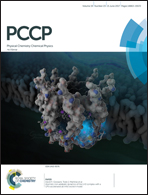Tunable electronic structure and magnetic moment in C2N nanoribbons with different edge functionalization atoms†
Abstract
First principles calculations based on density functional theory were carried out to study the electronic and magnetic properties of C2N nanoribbons (C2NNRs). The electronic structure could be modified by different methods using saturated or co-saturated H, O, and F on the edges, which can provide a new pathway at the nanoscale for fabricating 2D spintronic materials. It was found that the pristine armchair C2NNR (A-C2NNR) is a nonmagnetic semiconductor with a direct band gap, while the pristine zigzag C2NNRs (Z-C2NNRs) can show either magnetic semiconductor with an indirect band gap or magnetic metallic behavior depending on its ribbon widths. A-C2NNRs with one type of atom (H, O or F) saturated on the edges are nonmagnetic, while H and O (F and O) co-saturated A-C2NNRs show magnetic ground states. H and O (F and O) co-saturated Z-C2NNRs share a larger magnetic moment compared to the case with H, O and F saturated on the edges. Furthermore, O-saturated Z-C2NNR is a spin “gapless” semiconductor. Additionally, there is no need to spin flip in the process of electronic transition near the Fermi level. Therefore, C2NNRs might have potential applications in photoelectronic and spinelectronic devices.



 Please wait while we load your content...
Please wait while we load your content...